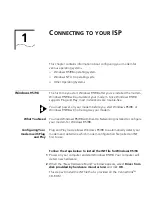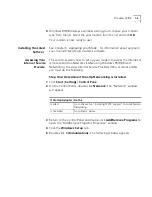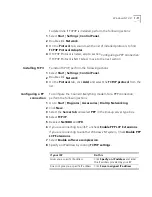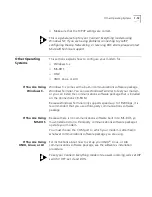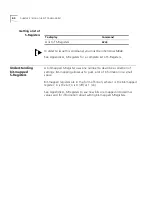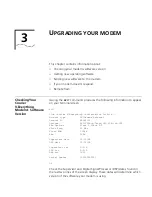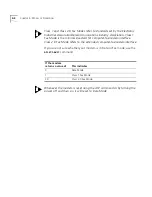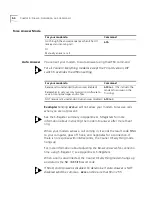
2
U
SING
THE
AT C
OMMAND
S
ET
This chapter includes information about
■
Basic AT commands
■
Using S-Registers
■
Understanding bit-mapped S-Registers
Overview
You can use AT commands to change your modem settings at any time.
To send AT commands to your modem, you need to put your
communications software in Terminal Mode. In terminal mode, what you
type is sent directly to the modem.
General rules for
using AT commands
You must follow some general guidelines to send AT commands to your
modem:
■
Type AT before each command and press
Enter
after each command.
The exceptions are A/, A> and +++, which require neither
AT nor
Enter
.
■
Leave zeroes off the end of AT commands. A missing numeric
parameter is assumed to be a zero. For example, ATE is equivalent t
ATE0
■
Create compound commands of up to 56 characters between AT and
Enter
. See the following example.
Summary of Contents for Courier
Page 12: ......
Page 28: ...1 14 CHAPTER 1 CONNECTING TO YOUR ISP ...
Page 36: ...3 4 CHAPTER 3 UPGRADING YOUR MODEM ...
Page 58: ...6 6 CHAPTER 6 WORKING WITH MEMORY ...
Page 64: ...8 4 CHAPTER 8 CONTROLLING EIA 232 SIGNALING ...
Page 72: ...9 8 CHAPTER 9 ACCESSING AND CONFIGURING THE COURIER V EVERYTHING MODEM REMOTELY ...
Page 80: ...10 8 CHAPTER 10 CONTROLLING DATA RATES ...
Page 96: ...12 6 CHAPTER 12 FLOW CONTROL ...
Page 108: ...13 12 CHAPTER 13 HANDSHAKING ERROR CONTROL DATA COMPRESSION AND THROUGHPUT ...
Page 112: ...14 4 CHAPTER 14 DISPLAYING QUERYING AND HELP SCREENS ...
Page 122: ...15 10 CHAPTER 15 TESTING THE CONNECTION ...
Page 142: ...17 8 CHAPTER 17 TROUBLESHOOTING ...
Page 156: ...A 14 APPENDIX A S REGISTERS ...
Page 172: ...B 16 APPENDIX B ALPHABETIC COMMAND SUMMARY ...
Page 178: ...C 6 APPENDIX C FLOW CONTROL TEMPLATE ...
Page 186: ...E 4 APPENDIX E V 25 BIS REFERENCE ...

